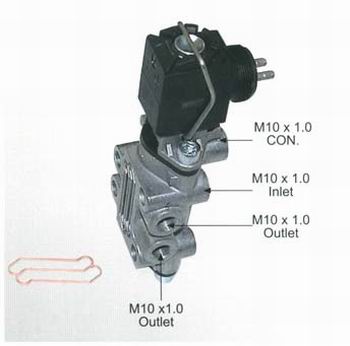Working principle of automobile solenoid valve

Features: It can work normally under vacuum, negative pressure and zero pressure, but the diameter is generally not more than 25mm.
Distributed direct acting solenoid valve:
Principle: It is a combination of direct acting and pilot type. When there is no pressure difference between the inlet and the outlet, after energization, the electromagnetic force directly lifts the pilot small valve and the main valve closing part in sequence and the valve opens. When the inlet and outlet reaches the starting pressure difference, after energization, the electromagnetic force pilot small valve, the pressure in the lower chamber of the main valve rises, and the pressure in the upper chamber decreases, thereby using the pressure difference to push the main valve upwards; Force or medium pressure pushes the closing piece and moves downward to close the valve.
Features: It can operate reliably at zero pressure difference or vacuum and high pressure, but the principle of larger power solenoid valve traces the development history of solenoid valve. So far, domestic and foreign solenoid valves are divided into three categories in principle (ie : Direct-acting type, step-by-step pilot type), and from the difference in valve disc structure and material and the difference in principle, it is divided into six sub-categories (direct-acting diaphragm structure, step-by-step heavy diaphragm structure, pilot membrane) Structure, direct-acting piston structure, step-by-step direct-acting piston structure, pilot piston structure).
Direct acting solenoid valve:
Principle: When energized, the electromagnetic coil generates electromagnetic force to lift the closing member from the valve seat, and the valve opens; when the power is turned off, the electromagnetic force disappears, the spring presses the closing member against the valve seat, and the valve closes.
Features: It can work normally under vacuum, negative pressure and zero pressure, but the diameter is generally not more than 25mm.
Distributed direct acting solenoid valve:
Principle: It is a combination of direct acting and pilot type. When there is no pressure difference between the inlet and the outlet, after energization, the electromagnetic force directly lifts the pilot small valve and the main valve closing part in sequence and the valve opens. When the inlet and outlet reaches the starting pressure difference, after energization, the electromagnetic force pilot small valve, the pressure in the lower chamber of the main valve rises, and the pressure in the upper chamber decreases, thereby using the pressure difference to push the main valve upwards; Force or medium pressure pushes the closing piece and moves downward to close the valve.
Features: It can operate reliably at zero pressure difference or vacuum and high pressure, but the power is large, and it must be installed horizontally.
Pilot solenoid valve:
Principle: When the power is turned on, the pilot hole is opened by electromagnetic force, the pressure in the upper chamber drops rapidly, and a high and low pressure difference is formed around the closing member. The fluid pressure pushes the closing member upward and the valve opens; when the power is turned off, the spring force controls the pilot The orifice is closed, and the inlet pressure quickly forms a low, high, and high pressure differential around the valve closing member through the bypass hole. The fluid pressure pushes the closing member downward to close the valve.
Features: The upper limit of the fluid pressure range is higher, and can be installed arbitrarily (need to be customized) but must meet the fluid pressure differential conditions.
, It must be installed horizontally.
Pilot solenoid valve:
Principle: When the power is turned on, the pilot hole is opened by electromagnetic force, the pressure in the upper chamber drops rapidly, and a high and low pressure difference is formed around the closing member. The fluid pressure pushes the closing member upward and the valve opens; when the power is turned off, the spring force controls the pilot The orifice is closed, and the inlet pressure quickly forms a low, high, and high pressure differential around the valve closing member through the bypass hole. The fluid pressure pushes the closing member downward to close the valve.
Features: The upper limit of the fluid pressure range is higher, and can be installed arbitrarily (need to be customized) but must meet the fluid pressure differential conditions.
Fork Type Terminals,Insulated Bullet Sockets Terminals,Insulated Bullet Terminals,Type Fork Insulate Terminal
Taixing Longyi Terminals Co.,Ltd. , https://www.lycopperlugs.com